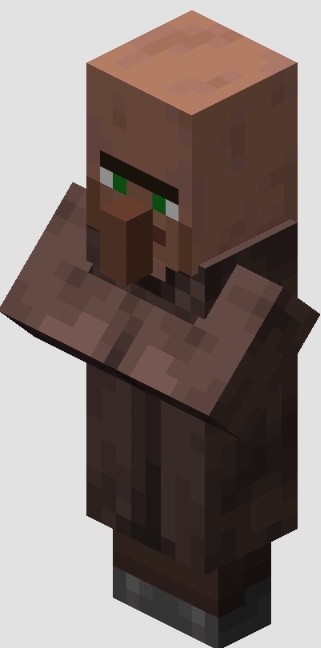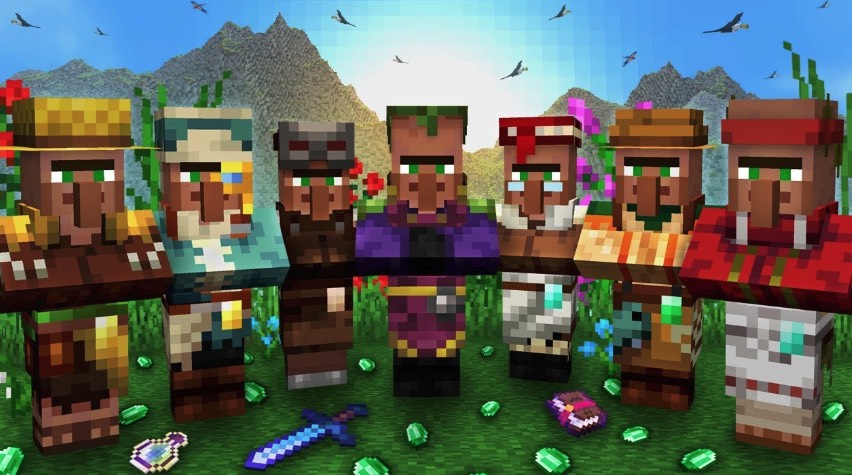In Minecraft, villagers are passive mobs who occupy villages, work different professions, breed, and interact amongst themselves and with players. They’re extremely important to the overall gameplay and GUI.
If you’re wondering how they do that, check our breakdown of the different types of villagers in Minecraft and their input.
How villagers are identified in Minecraft
Villagers are mainly identified based on their professions, which also influences their outfits.
The villages are spread across different biomes, and villagers usually spawn in them immediately after a village generates. Initially, the villagers are jobless and must search for job site blocks.
Villager job blocks
Any villager who has claimed a bed (except nitwits and babies) must search a 48-block horizontal block for a job site block to seek employment. When villagers spot an unclaimed job site block, they must pathfind towards it and claim it before another villager gets to it. That’s how they acquire the job and profession.
If the job site block is already claimed, the owner will emit green particles to deter other villagers from claiming the job block. However, if they relinquish it for whatever reason, another unemployed villager can claim it.
READ: What do llamas eat in Minecraft to breed?
If a job site block breaks or gets broken, the owner emits anger particles and becomes jobless. However, they’ll keep the profession if they’d traded.
Villagers who don’t go to their job site blocks for some time end up employed. But, they can get back to the profession if the job site block hasn’t been claimed, and they can find their way to it.
Other factors to note include:
- Villagers with professions but no job site will always be looking for a job block.
- A villager who hasn’t traded can claim any job block site and change profession.
- Villagers who have traded can only claim a job block site related to their profession.
- In the Java edition, villagers can only claim job site blocks on the ground. Also, they must be awake while making the claim.
- In Bedrock Edition, villagers can claim job site blocks while asleep.
Villager professions
Here are the villager jobs found in Minecraft:
1. Armorer
Outfit: Welding mask
This is one of the first professions a villager can claim. Its job site block is a blast furnace. The main job of the armorer is to craft and trade armor pieces, bells, and shields. You can get enchanted diamond armor from the expert-level armorer if you upgrade the trading level.
2. The Farmer
Outfit: Straw hat
The farmer is the most common and popular type of villager in Minecraft. They engage in farming and produce food items that they trade with players and other villagers.
So, if you want crops and other natural food items, you should look for a farmer at the composer. Also, they have some of the best Minecraft potions.
3. The weaponsmith
Outfit: eyepatch and black apron
A weaponsmith crafts and repairs all tools and weapons at the grindstone. They are the source of almost all weapons in the game. So, if you want a sword or axe—with or without enchantments, you must find a weaponsmith.
Additionally, you can get a bell from them too. If you’re lucky enough to find their chests, you’re guaranteed a wide range of quality weapons.
4. Cleric

Outfit: Purple apron and creeper cloak
The Cleric is a unique profession that trades rare magical items in Minecraft. Examples include the glowstone, ender eye, lapis lazuli, redstone dust, and Bottle o’ Enchanting. Clerics use the brewing stand as their job site block. Therefore, if you don’t find a Cleric in your village, create a brewing stand and let a villager claim it.
5. Toolsmith
Outfit: Black apron
Toolsmiths deal with tools. You can trade with them for in-game tools like axe, pickaxe, hoe, and shovels. If you upgrade to higher trading levels, you’ll be eligible to trade for enchanted tools.
Their job site block is at the smithing table, which players can use to upgrade their diamond tools to netherite tools.
6. Stone Mason
Outfit: Black apron and black gloves
In Minecraft Java Edition, the stone mason is known as the mason. Their job is to provide different stones through trade. If you trade at lower levels, you get various types of bricks, a variety of polished stone blocks, and dripstone blocks.
At higher levels, you can trade for glazed terracotta, colored terracotta quartz pillars, and blocks of quartz. They craft all the stones and blocks at their job site block the stonecutter.
7. Shepherd
Outfit: brown hat with a white apron
The job site block for a shepherd is a loom. However, players can use it to create unique patterns on banners with the help of an in-game editor.
The shepherds’ main trading items are carpets, banners, colored wool, and paintings. But, you can also get beds and shears from them.
READ: What food do sheep eat in Minecraft to breed?
8. Librarian
Outfit: Eyeglasses and a book as a hat
The librarian operates from the lectern. A dynamic job site block is only used in multiplayer mode to hold books so multiple players can read them simultaneously.
You can get trade items from this villager include enchanted books, bookshelves, glass blocks, lanterns, compasses, clocks, and name tags.
9. Leatherworker
Outfit: Brown apron and brown gloves
Leather workers in Minecraft use the cauldron as their job site block. The place can store water, lava, and powder snow.
But, more importantly, leather workers use it to produce leather armor, leather horse armor, and horse saddle for trade with players and villagers.
10. Fisherman
Outfit: Fisher hat
Fishermen are the go-to villagers for a bucket of cod, cooked cod, and salmon. Also, you can trade for a campfire and an enchanted fishing road from them. Their job site block is a barrel ideal for storing different items.
11. Butcher
Outfit: Red headband and white apron
To find a butcher, you need to locate a smoker which is their job site block. They have raw beef, raw mutton, raw chicken, cooked meat, rabbit stew, and cooked chicken too.
They will trade them for different amounts of emerald. Their endless supply of meat will help whenever you’re hungry. Also, you should note that the smoker cooks meat faster than a furnace.
12. Fletcher
Outfit: Hat with feather and quiver on the back
The fletcher is a rare profession in Minecraft. His main task is to trade arrows, flint, bow, and crossbows with players and other villagers. If you upgrade and trade with high-level Fletchers, you’ll get enchanted bows, enchanted crossbows, and tipped arrows. Their job site block is the fletching, which can’t be used for any other function.
13. Cartographer
Outfit: Golden monocle
Cartographers hold some of the most valuable trade items in Minecraft. Namely, empty maps, empty frames, empty banners, and ocean and woodland explorer maps.
The maps will help you find buried treasures, woodland mansions, and ocean monuments. So, you should prepare to part with equally-valuable items when trading with a Cartographer. You’ll find them next to a cartography table.
Other types of villagers in Minecraft
The following Minecraft villagers don’t have any profession.
1. Nitwit
Outfit: Green coated, no badge
Nitwits exist mainly for aesthetics. They can’t trade or claim any job. So, after spawning or being born, Nitwits just wander around in the village making mumbling sounds.
2. Unemployed villager

Outfit: Base clothing of biome without extra features
Like Nitwits, unemployed villagers wander around the village without a profession. However, they can claim a job site block and become employed.
Usually, every villager is unemployed at the start of the game. Later you’ll have baby villagers growing into unemployed villagers until they find a job site block. Also, an employed villager can become unemployed if their job site block is destroyed.
3. Baby villagers
These are young villagers who spawn when a village is built or produced by breeding adult villagers. The breeding takes place provided the adult villagers are willing, and there are unclaimed beds within the village. The baby villagers usually wander around the village, randomly entering and leaving houses as they please. They remain unemployed until they grow up.
4. Wandering trader
Wandering traders spawn close to the player or near bells with two leashed trader llamas. They look and move like villagers. You can trade emeralds to them for a variety of unique items. But you can’t trade items for emeralds.
The wandering trader can’t work at a job site block. They also get attacked by zombie variants, and since they don’t have a zombified form, they die when killed by the zombie.
To protect themselves from hostile mobs at night, the wandering trader drinks a potion of invisibility. Later in the morning, they’ll drink a milk bucket to remove the invisibility.
5. Zombie villager
A zombie villager is a villager who has been attacked and killed by a zombie. The chance of a villager turning into a zombie villager after being killed varies depending on the game’s difficulty:
- Easy difficulty = 0% chance
- Normal difficulty = 50% chance
- Hard difficulty = 100% chance
Also, there’s a 5% chance of zombie villagers spawning naturally in the Overworld under the same conditions as a normal zombie.
6. Witches
These are hostile villager-like mobs. They spawn in the overworld when the light level is 7 or below, as part of raids, in swamp huts, or when a villager is struck by lightning. If a villager turns into a witch, they can’t be turned back.
The witches are passive towards villagers and wandering traders. They only attack when attacked or a fellow witch has been attacked in the area. They will throw splash potions of harming slowness, weakness, and poison. If any negative splash potions hit an illager, the illager retaliates, resulting in a fight (Bedrock edition).
They take healing potions whenever they take damage, fire resistance potions when on fire, and water breathing potions when underwater.
7. Illagers
These are also hostile villager-like mobs. They spawn in woodland mansions, pillager outposts, illager patrols, or raids. They are considered outcasts from villages where it’s believed villagers expelled them permanently after committing unspeakable crimes and ill-willing.
The illagers fall under the following varieties:
- Vindicators
- Evokers
- Pillagers
- Illusioners
- Vexes and ravagers
They will attack almost anybody in the game. From players, villagers, wandering traders, and iron golems. However, they don’t move around seeking villagers and will only come to villages during raids and patrols.
8. NPC (Non-Player Character)
NPCs are villager-like mobs in the Education and Bedrock editions (when educational features are enabled). They move like players and are the only characters you can chat with in a single-player game. Also, they’re able to turn their heads and rotate 360 degrees.
Nobody can push them, but they’re affected by gravity. If you use a bubble column on a NPC it goes up, while a block will fall like armor when broken under a NPC.
NPCs can’t die from the wither effect or fatal poison. They don’t take any of the following damages:
- Fall damage
- Fire damage
- Drowning damage
- Suffocation damage
- External damage from player or mob.
However, they can die in the void.
How many villager jobs are there in Minecraft?
There are 13 villager jobs in Minecraft that can be assigned to unemployed villagers.
From this list, you now know the different villagers, how to make them, and their professions. This makes it easier to interact with them at different levels. We’ll update the list whenever new villagers are added to the game.
